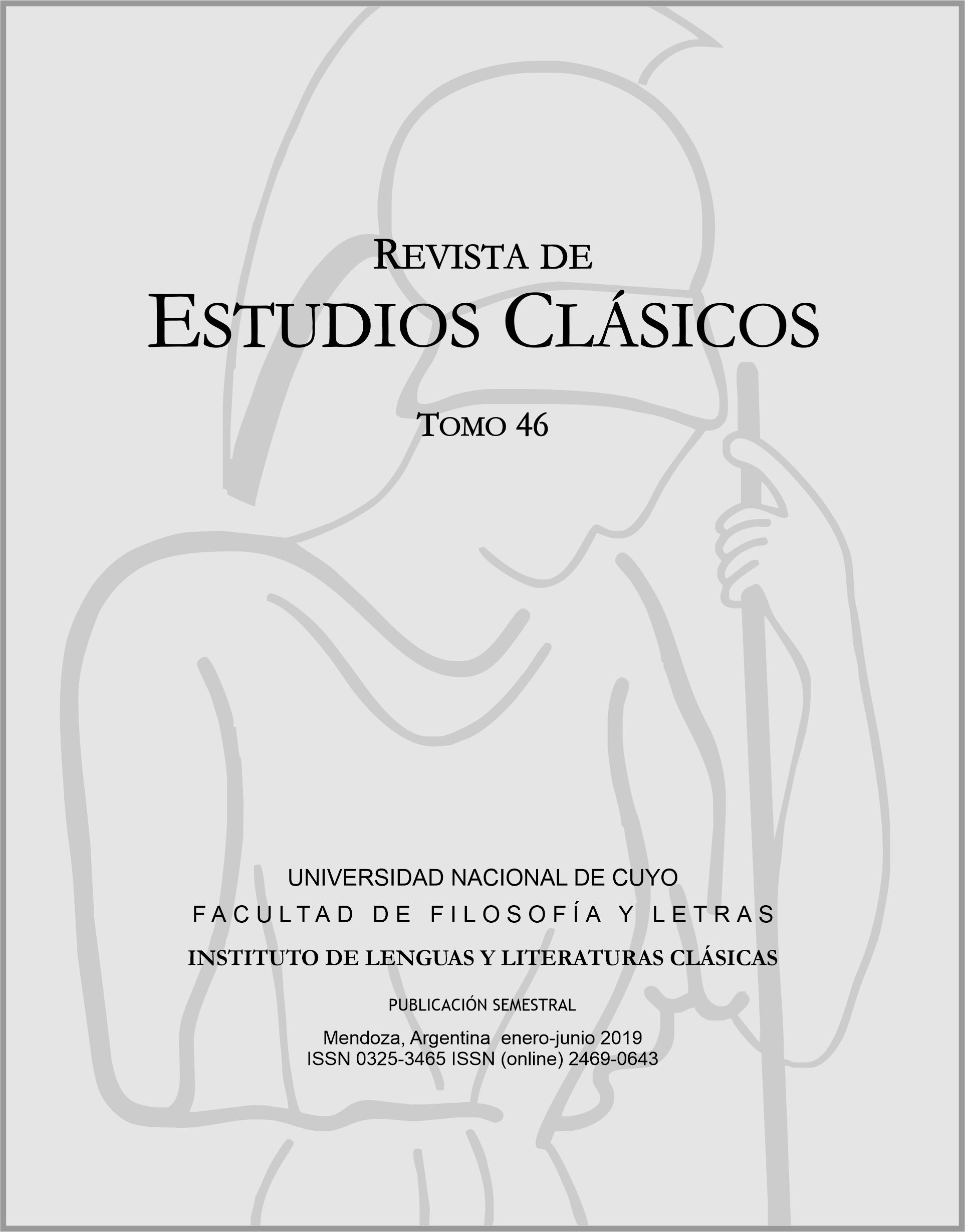Buitres, águilas y leones en Agamenón de Esquilo.
Keywords:
Animals, Agamemnon, tragedy, simile, prophecyAbstract
This paper analyses three parts of the work in which animals, lively depicted by Aeschylus, play a central role. The goal of this analysis is to
provide possible approaches to understanding what is said by these images concerning the human world depicted by the tragic writer and by
their role in the tragic development of the work. The starting point is the famous parodos in which the vultures’ simile appears, whose main figure
are Agamemnon and Menelaus (Ag. 40-67); next, it’s the analysis of the prophecy of Calchas, in which Agamemnon and Menelaus, compared
this time with eagles, play again central roles. Finally, the focus is set on what Bernard Knox (1952) called the lioncub parable, in which Helena
seems to be the main character (Ag. 717-736).
References
"”"”"”"”"”"”"” . (2000). Homero. Ilíada. Madrid: Gredos.
Denniston, J.D. y Page, D.L. (1986). Aeschylus. Agamemnon. Oxford Scholarly Editions Online.
Dimock, G. y Murray, A. T (1995). Homer. Odyssey: Books 1-12. Cambridge: Loeb.
"”"”"”"”"”"”"”"”"”"” . (1919). Homer. Odyssey: Books 13-24. Cambridge: Loeb.
Dolgert, S. (2012). Sacrificing Justice: Suffering Animals, the Oresteia, and the Masks of Consent. Political Theory, Vol. 40 (3). 263-289.
Fraenkel, Ed. (1962) Aeschylus. Agamemnon. Vol. I y II. Glasgow, New York, Toronto, entre otras: Oxford University Press.
García Gual, C. y Pabón, J. (2000). Homero. Odisea. Madrid: Gredos. Griffith, M. y Most, G. (ed.). Aeschylus II: The Oresteia. Chicago, London: University of Chicago Press.
Heat, J. (1999). The Serpent and the Sparrows: Homer and the Parodos of Aeschylus' Agamemnon. The Classical Quarterly, Vol. 49 (2). 396-407.
"”. (2005). The Talking Greek. Speech, Animals, and Other in Homer, Aeschylus and Plato. Cambridge, New York et. al.: Cambridge University Press.
Janko, R. (1980). Aeschylus' Oresteia and Archilochus. The Classical Quarterly, Vol. 30 (2). 291-293.
Kostuch, L. (2017). Do animals have a homeland? Ancient Greeks on the cultural identity of animals. HUMaNIMALIA, Vol. 9 (1). 69-87
Knox, B. (1952). The lion in the House. (Agamemnon 717-36 [Murray]). Classical Philology, Vol. 47 (1). 17-25.
Murray, A. T. y Wyat, W. F. (1924). Homer. Iliad. Volume I. Cambridge: Loeb.
"”"”"”"”"”"”"”"”"”"”"”"”. (1925). Homer. Iliad. Volume II. Cambridge: Loeb.
Person, A. C. (ed.). (2009). The Agamemnon of Aeschylus: With Verse Translation, Introduction and Notes. Cambridge, New York, et. al.: Cambridge University Press.
Reeves, Ch. (1960). The Parodos of the "Agamemnon". The Classical Journal, Vol. 55 (4). 165-171.
Scodel, R. (1999). Δόµων ἄγαλµα: Virgin Sacrifice and Aesthetic Object. Transactions of the American Philological Association (1974-2014), Vol. 126.
111-128.
"”"”"”"” . (2014). La tragedia griega. Una introducción. México D.F.: FCE.
Smyth, H. W. (1983). Aeschylus II: Agamemnon, Libation-Bearers, Eumenides, Fragments. London: Loeb.
Thumiger, Ch. (2008). ἀνάγκης ζεἐµατ’áἐµπεπτÏŽκαµεν: Greek Tragedy between human and animal. Leeds International Classical Studies 7. (3). 1-21.
West, M.L. (1979). The Parodos of the Agamemnon. The Classical
Downloads
Published
How to Cite
Issue
Section
License
Aquellos autores/as que tengan publicaciones con esta revista, aceptan los términos siguientes:
- Los autores/as conservarán sus derechos de autor y garantizarán a la revista el derecho de primera publicación de su obra, el cuál estará simultáneamente sujeto a laLicencia Creative Commons Atribución-NoComercial-CompartirIgual 2.5 Argentina (CC BY-NC-SA 2.5 AR). (https://creativecommons.org/licenses/by-nc-sa/2.5/ar/)que permite a terceros compartir la obra siempre que se indique su autor y su primera publicación esta revista.
- Los autores/as podrán adoptar otros acuerdos de licencia no exclusiva de distribución de la versión de la obra publicada (p. ej.: depositarla en un archivo telemático institucional o publicarla en un volumen monográfico) siempre que se indique la publicación inicial en esta revista.
- Se permite y recomienda a los autores/as difundir su obra a través de Internet (p. ej.: en archivos telemáticos institucionales o en su página web) antes y durante el proceso de envío, lo cual puede producir intercambios interesantes y aumentar las citas de la obra publicada. (Véase El efecto del acceso abierto).












